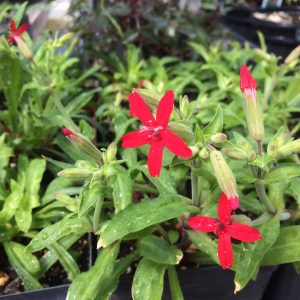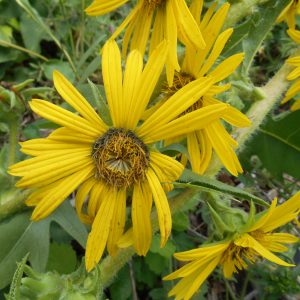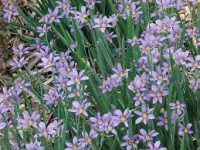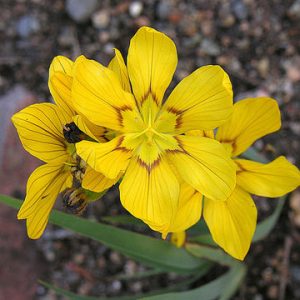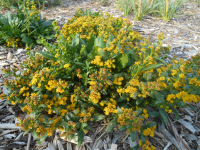Shop
Showing 689–696 of 788 results
-
Silene virginica Fire pink Z 4-8 Short-lived perennial, 2-3 years
Real red, hence the name Fire (not pink in color), flowers of five notched petals flaring out from a tube, blooms late spring and early summer. Named “pink” because it is botanically in the family known as Pinks, Dianthus.
ARCHIVED
Note: This is a plant not currently for sale. This is an archive page preserved for informational use.
Real red, hence the name Fire (not pink in color), flowers of five notched petals flaring out from a tube, blooms late spring and early summer. Named “pink” because it is botanically in the family known as Pinks, Dianthus.
Size: 12-18” x 9-18”
Care: part shade in moist well-drained to well-drained soil.
Native: nearly entire eastern half of No. America. Endangered species in WI.
Wildlife Value: attracts hummingbirds.1st collected by John Banister (1654-1692) Anglican minister who searched and found many plants in the Virginia colony, losing his life when he was accidentally shot along the Roanoke River while collecting plants.
-
Silphium laciniatum Compass plant Z 4-9
Tall, sunflower-like plant with big, deeply lobed, hairy leaves, that move north and south to follow mid-day sun. Two to five inch wide, sunny-yellow daisies grow at intervals along the top half of the stiff, square, sticky stem from mid-summer into fall.
Tall, sunflower-like plant with big, deeply lobed, hairy leaves, that move north and south to follow mid-day sun. Two to five inch wide, sunny-yellow daisies grow at intervals along the top half of the stiff, square, sticky stem from mid-summer into fall.
Size: 6- 12’ x 24”
Care: sun to part shade in moist to well-drained soil with its deep taproot
Native: East and central U.S. as far west as the Great Plains, Wisconsin native
Wildlife Value: pollinated by bumblebees, Miner bees, large leaf Cutting and solitary bees, Goldfinches feast on the seeds in fall.
Awards: Missouri Botanic Garden Plant of MeritNatives chewed the plant’s sap like chewing gum. Lakota Sioux made an infusion of the plant to deworm horses and humans and to break up congestion in the lungs. Grew in Bartram’s colonial nursery by 1770’s. Grown at America’s 1st botanic garden, Elgin Botanic Garden 1811.
-
Silphium perfoliatum Cup plant Z 3-9
Golden daisies waive at the sun from July to September, its cup shaped leaves hold water where butterflies drink & bathe
Golden daisies waive at the sun from July to September, its cup shaped leaves hold water where butterflies drink & bathe
Can not ship to: Connecticut and New York
Size: 7’ x 3’
Care: full sun to part shade in moist to moist well-drained soil
Native: Central North America, native to Wisconsin.
Awards: England’s Royal Horticultural Society Award of MeritSap used by Native Americans to chew and freshen breath. Also used to cure colds, neuralgia, fever, and liver disorders. The Chippewa used it to stop lung hemorrhaging, menstrual bleeding, and cure chest pain. Winnebago drank a potion from the plant to purify themselves before a buffalo hunt. For the Iroquois it cured paralysis, prevented children from seeing ghosts and illness caused by the dead. Lakota Sioux children sometimes chewed resin like chewing gum. An infusion of the whole plant is used to rid horses and humans of intestinal worms. An infusion of the leaves is used to loosen phlegm in the lungs. Described and classified in 1753.
-
Sisyrinchium albidum White blue-eyed grass Z 3-10
White or pale blue star-shaped flowers with yellow centers blossom over short, grass-like foliage in late spring-early summer.
ARCHIVED
Note: This is a plant not currently for sale. This is an archive page preserved for informational use.
White or pale blue star-shaped flowers with yellow centers blossom over short, grass-like foliage in late spring-early summer.
Size: 18-24” x 6-12”
Care: sun in moist well-drained soil
Native: East coast from Maine to Florida and west as far as Wisconsin
Wildlife Value: attracts bees & butterflies, Deer resistant.
Size: Menominee kept this in their house or pocket to ward off snakes.Menominee kept this in their house or pocket to ward off snakes. First published in 1832.
-
Sisyrinchium angustifolium Blue eyed grass Z 3-9
Petite iris-like foliage sporting blue saucer-shaped flowers with bright yellow stamens in summer.
Petite iris-like foliage sporting blue saucer-shaped flowers with bright yellow stamens in summer.
Size: 12" x 6"
Care: Sun in well-drained soil
Native: North America, Wisconsin native.Mahuna Indians of So. California made a tea from the entire plant to expel stomach worms. In cultivation by 1732. Named by Philip Miller, gardener of the Chelsea Botanic Garden, in Gardeners’ Dictionary .
-
Sisyrinchium macrocarpum Argentinian blue-eyed grass Z 5-9
In summer large yellow cups with red line encircle the center, above petite iris-like foliage
ARCHIVED
Note: This is a plant not currently for sale. This is an archive page preserved for informational use.
In summer large yellow cups with red line encircle the center, above petite iris-like foliage.
Size: 6-12” x 9-12”
Care: sun in moist well-drained soil
Native: Argentina’s central & southern cordillerasDescribed in 1881.
-
Solidago caesia syn. Solidago axillaris Blue-stemmed goldenrod, Wreath goldenrod Z 4-9
Graceful, arching wands of clustered gold, with contrasting blue-green stems in September-October. One of the last perennials to bloom. Clump forming, noninvasive perennial.
Graceful, arching wands of clustered gold, with contrasting blue-green stems, in September-October. Clump forming, noninvasive perennial.
Size: 18-24” x 16-20”
Care: part shade to shade in well-drained soil, drought tolerant
Native: Nova Scotia to WI, south to FL and west to TX, Wisconsin native
Wildlife Value: With both nectar and pollen this attracts, bees, wasps and flies. It is host to caterpillars of some moths.The Latin name is a combination of solidus and ago, meaning “I make whole”, referring to its historic medicinal uses. According to William Cullina it has antioxidant, diuretic, astringent and antifungal properties and was used to treat urinary tract and yeast infections, sore throats and diarrhea. (W. Cullina, NEWFS, p. 197) Named by Swedish botanist Linnaeus in 1753.
-
Solidago cutleri Cutler’s alpine goldenrod Z 3-9
Golden tufts of flowers on this mounding, compact, bone-hardy goldenrod July-September
Golden tufts of flowers on this mounding, compact, bone-hardy goldenrod July-September
Size: 6-10” x 12”
Care: sun in well-drained to moist well-drained soil
Native: Mountains of New England and NY, north through Nova Scotia
Wildlife Value: attracts butterfliesNamed for New England plant explorer Manasseh Cutler , Rhodora 10(113): 87. 1908 by M.L. Fernald

